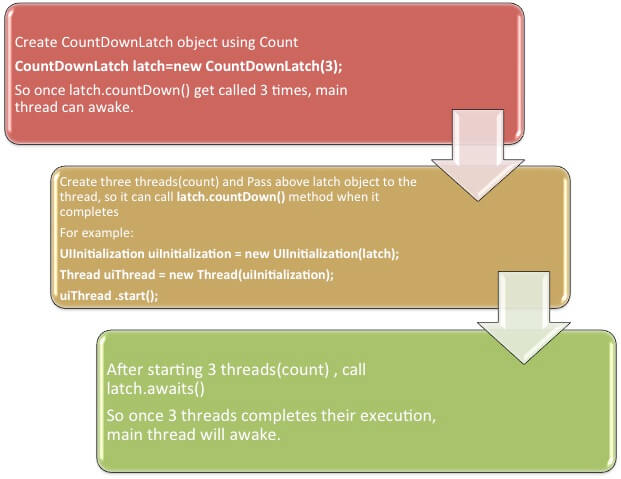Table of Contents
CountDownLatch is synchronisation aid that allows one or more threads to wait until set of operations being performed in other threads completes.latch.countDown() once they complete some operation.So count is reduced by 1 whenever latch.countDown() method get called, so if count is n that means count can be used as n threads have to complete some action or some action have to be completed n times.
For example:
Below diagram will make you clear. It is an example how CountDownLatch can be used.

Program :
|
1 2 3 4 5 6 7 8 9 10 11 12 13 14 15 16 17 18 19 20 21 22 23 24 25 26 27 |
package org.arpit.java2blog.thread; import java.util.concurrent.CountDownLatch; public class UIInitialization implements Runnable{ CountDownLatch latch; UIInitialization(CountDownLatch latch) { this.latch=latch; } @Override public void run() { System.out.println("Initializing UI"); try { Thread.sleep(3000); } catch (InterruptedException e) { // TODO Auto-generated catch block e.printStackTrace(); } System.out.println("Done with UI Initialization"); latch.countDown(); } } |
|
1 2 3 4 5 6 7 8 9 10 11 12 13 14 15 16 17 18 19 20 21 22 23 24 25 26 27 |
package org.arpit.java2blog.thread; import java.util.concurrent.CountDownLatch; public class LoggingInitialization implements Runnable{ CountDownLatch latch; LoggingInitialization(CountDownLatch latch) { this.latch=latch; } @Override public void run() { System.out.println("Initializing Logging"); try { Thread.sleep(2000); } catch (InterruptedException e) { // TODO Auto-generated catch block e.printStackTrace(); } System.out.println("Done with Logging Initialization"); latch.countDown(); } } |
|
1 2 3 4 5 6 7 8 9 10 11 12 13 14 15 16 17 18 19 20 21 22 23 24 25 26 27 |
package org.arpit.java2blog.thread; import java.util.concurrent.CountDownLatch; public class DatabaseInitialization implements Runnable{ CountDownLatch latch; DatabaseInitialization(CountDownLatch latch) { this.latch=latch; } @Override public void run() { System.out.println("Initializing Database"); try { Thread.sleep(5000); } catch (InterruptedException e) { // TODO Auto-generated catch block e.printStackTrace(); } System.out.println("Done with database Initialization"); latch.countDown(); } } |
|
1 2 3 4 5 6 7 8 9 10 11 12 13 14 15 16 17 18 19 20 21 22 23 24 25 26 27 28 29 30 31 32 33 34 35 36 37 |
package org.arpit.java2blog.thread; import java.util.concurrent.CountDownLatch; public class CountDownLatchMain { public static void main(String[] args) { try { CountDownLatch latch = new CountDownLatch(3); // Initializing three dependent thread i.e. UI, database and logging UIInitialization uiInitialization = new UIInitialization(latch); Thread uiThread = new Thread(uiInitialization); DatabaseInitialization dataBaseInitialization = new DatabaseInitialization(latch); Thread databaseThread = new Thread(dataBaseInitialization); LoggingInitialization loggingInitialization = new LoggingInitialization(latch); Thread loggingThread = new Thread(loggingInitialization); uiThread.start(); databaseThread.start(); loggingThread.start(); // Main thread will wait until above threads get completed latch.await(); System.out.println("Initialization has been completed, main thread can proceed now"); } catch (InterruptedException e) { e.printStackTrace(); } } } |
|
1 2 3 4 5 6 7 8 9 |
Initializing UI Initializing Database Initializing Logging Done with Logging Initialization Done with UI Initialization Done with database Initialization Initialization has been completed, main thread can proceed now |
Why not use join instead of CountDownLatch:
As you might know you can use join for this situation too but you have to manually handles it. Most of people use [ExecutorService](https://java2blog.com/java-executorservice-example-using-callable-future/ “ExecutorService”) for handling threads now and CountDownLatch works good with it. As CountDownLatch is task oriented , you can submit multiple tasks to thread pool and CountDownLatch will ensure execution of original thread once set of other dependent threads get completed.
Please go through top 50 core java interview questions for more interview questions.



